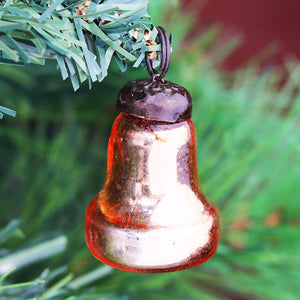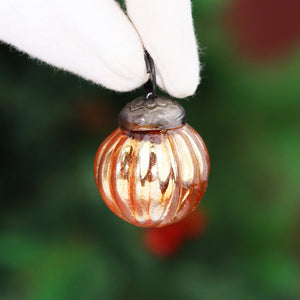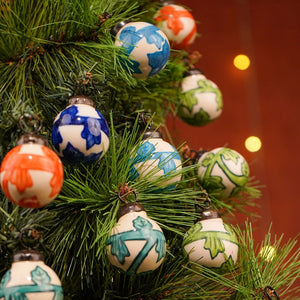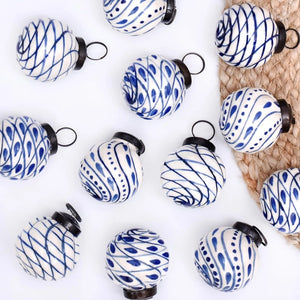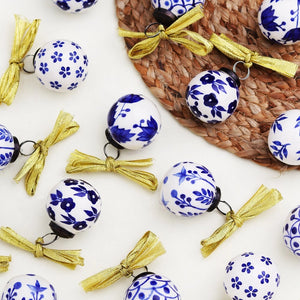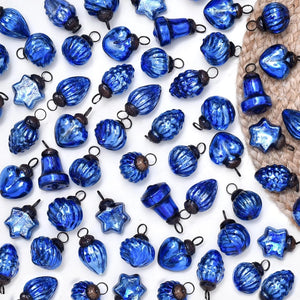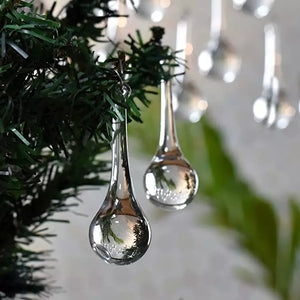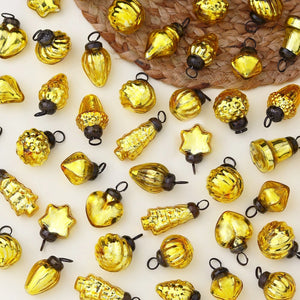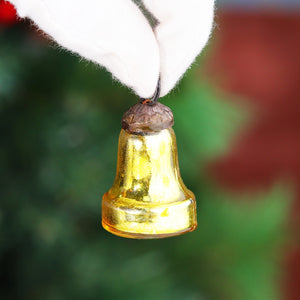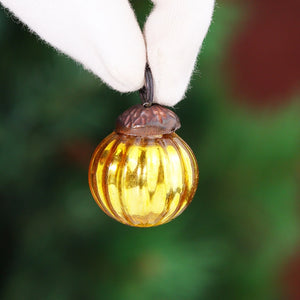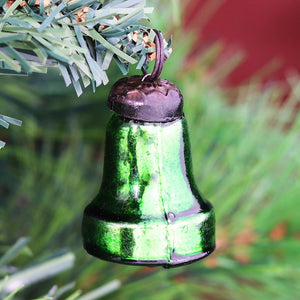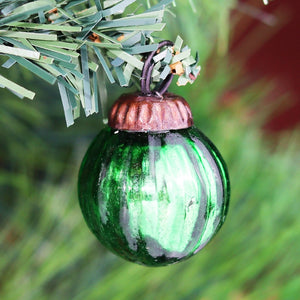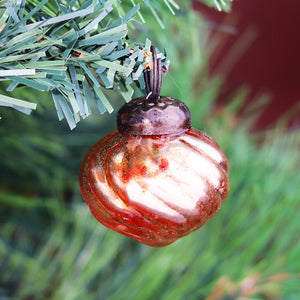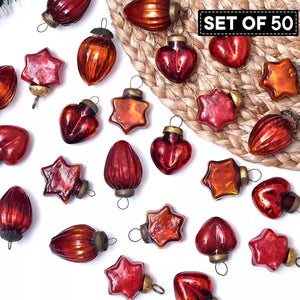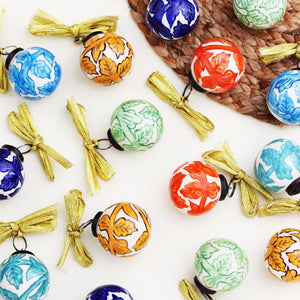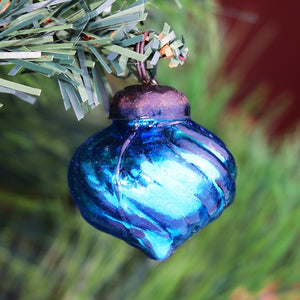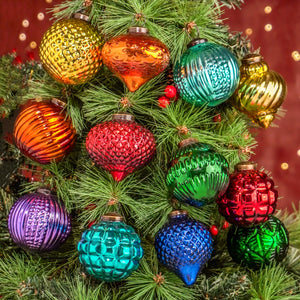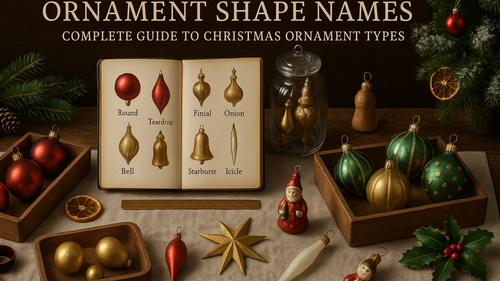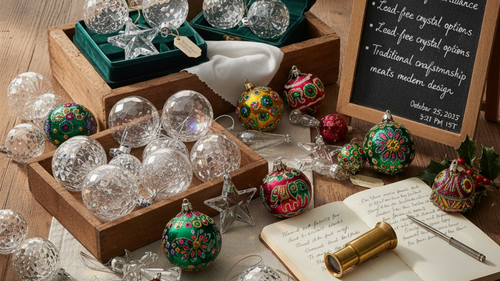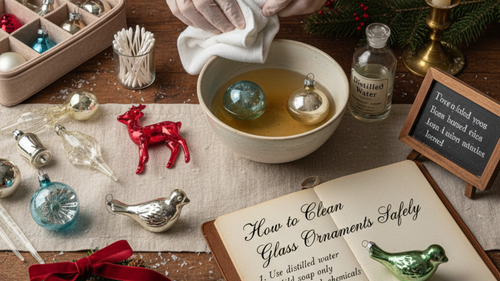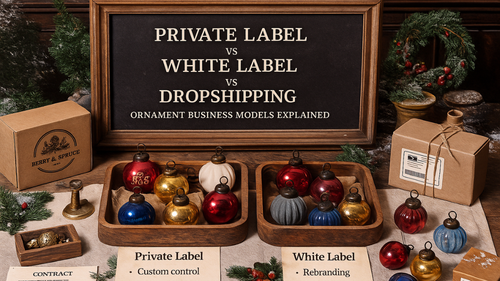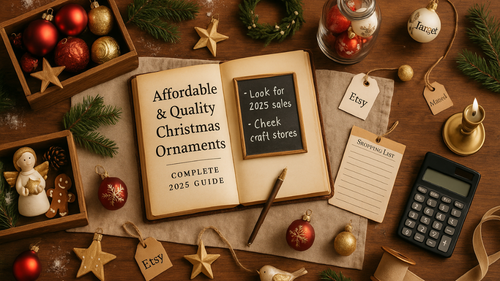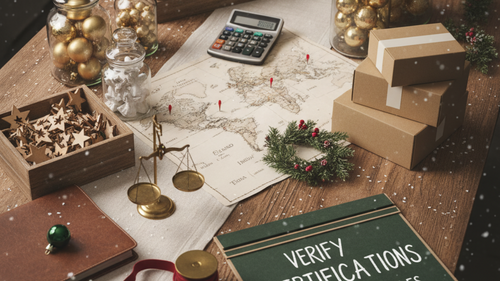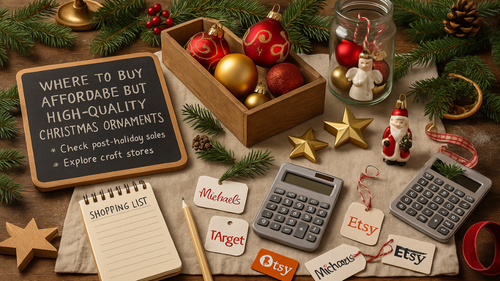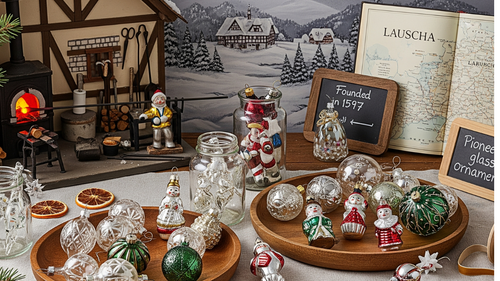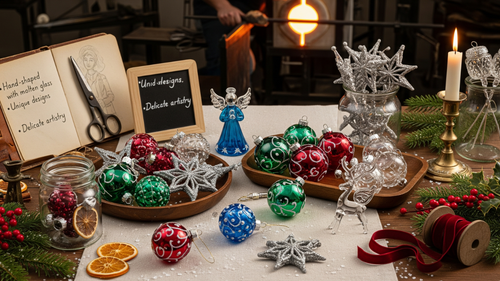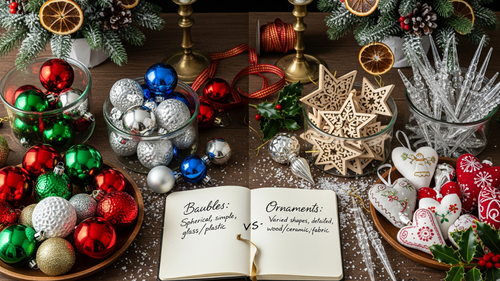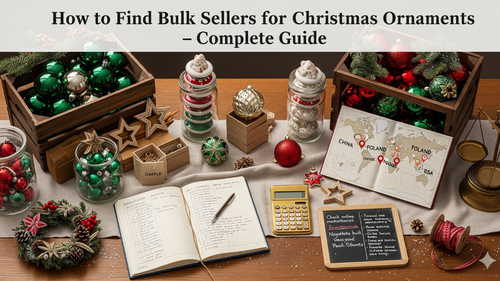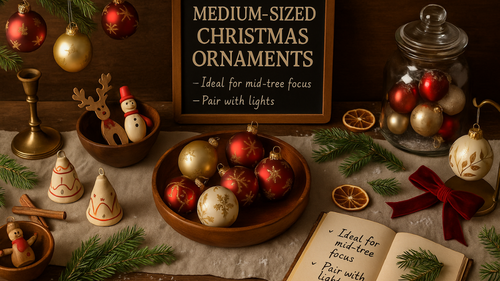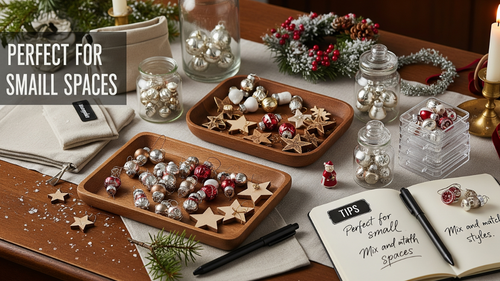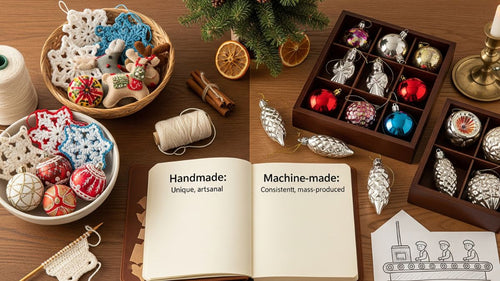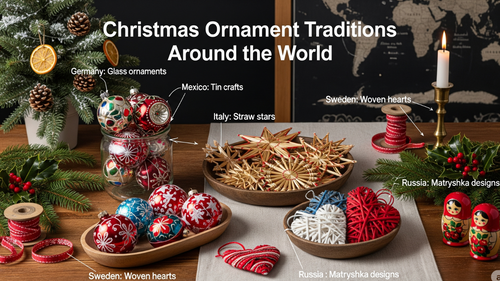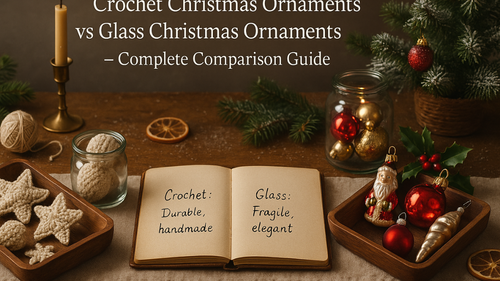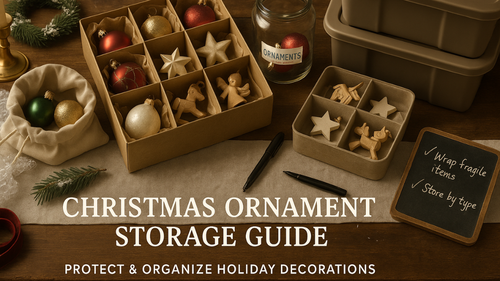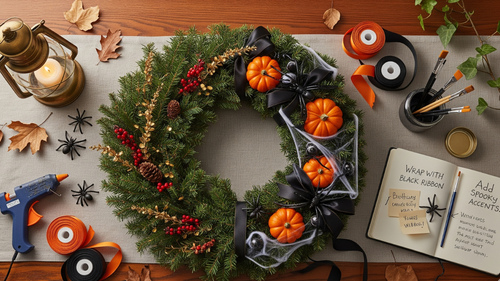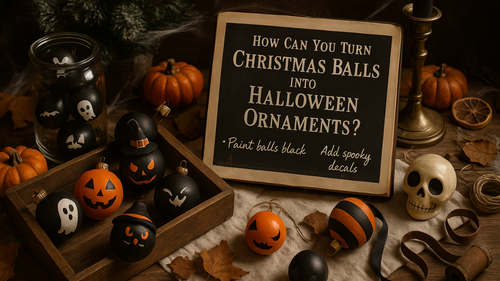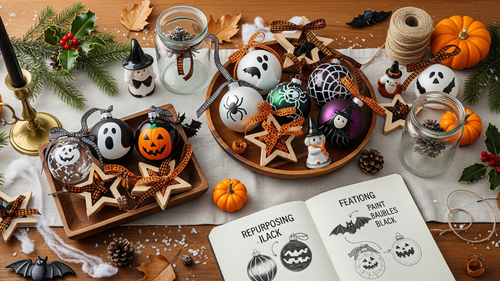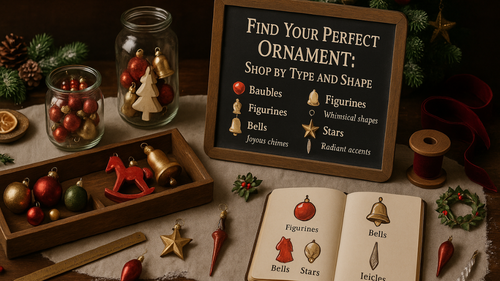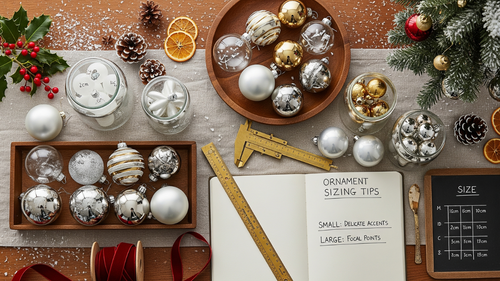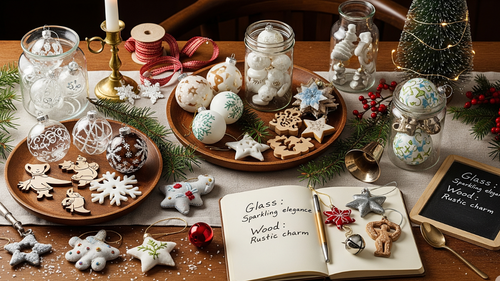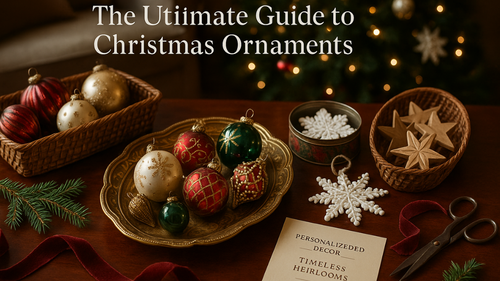Christmas ornaments transform ordinary spaces into magical holiday environments while preserving family memories across generations. Whether you're crafting personalized decorations, caring for precious heirloom pieces, or building a collector's showcase, understanding ornament history, techniques, and preservation ensures your holiday traditions continue beautifully.
This comprehensive guide covers everything from 16th-century German glass-blowing origins to modern DIY techniques that create meaningful keepsakes. You'll discover safe cleaning methods that protect delicate surfaces, storage solutions that prevent damage, and creative display ideas that showcase your ornaments year-round.
Expert tips throughout this guide help both beginners and experienced decorators make informed decisions about materials and construction methods while avoiding common mistakes that damage valuable pieces. From selecting the right supplies to understanding collector market trends, these insights support successful ornament projects and preservation efforts.
Table of Contents
Key Takeaways
- Historical Value: Christmas ornaments evolved from 16th-century German glass baubles to today's diverse materials and personalized designs
- DIY Success: Safe materials, proper techniques, and age-appropriate projects create meaningful handmade decorations
- Preservation Priority: Proper storage, gentle cleaning, and climate control extend ornament life for decades
- Collecting Strategy: Focus on provenance, condition, and rarity while protecting displays from UV damage
- Gift Potential: Personalized ornaments make cherished keepsakes with proper packaging and care instructions
Where Do Christmas Ornaments Come From?
Ornaments began as 16th-century German glass baubles and evolved through Victorian crafts to today's personalized, themed décor. The tradition of decorating Christmas trees with ornamental objects traces back to Lauscha, Germany, where skilled glassblowers created the first delicate baubles that would inspire generations of holiday decorators.
Origins & Early Designs
German glassblowing artisans in the 1800s pioneered ornament creation using fruit and nut motifs. These early designs featured hand-blown glass shaped into apples, pears, and walnuts, often silvered with mercury glass techniques. Tinsel and paper decorations accompanied these glass pieces, creating the foundation for modern ornament traditions.
The Woolworth's Five-and-Dime stores introduced German ornaments to America in the 1880s. F.W. Woolworth himself traveled to Lauscha to secure direct importing agreements, making decorative glass baubles accessible to middle-class families nationwide.
Featured Products
Evolution by Era
Victorian craftspeople elevated ornament-making through elaborate handcrafts including beaded garlands, fabric angels, and intricate paper cutouts. The era emphasized sentimental value, with families creating heirloom pieces that passed between generations.
Mass production revolutionized ornament availability during the early 1900s. Companies like Shiny Brite introduced shatterproof plastics and standardized manufacturing processes. These innovations made ornaments affordable while maintaining decorative appeal across diverse economic backgrounds.
Cultural Significance
Ornament symbols, colors, and motifs carry deep cultural meaning across different regions. European traditions favor red and gold combinations representing prosperity and protection. Scandinavian designs emphasize natural materials like straw and wood, reflecting agricultural heritage and seasonal cycles.
Featured Products
Religious symbolism appears in star shapes representing the Star of Bethlehem, angel figures symbolizing divine messengers, and bell ornaments signifying joy and celebration. These meaningful elements transform simple decorations into spiritual expressions of faith and hope.
Famous Historical Ornaments
The White House Christmas tree features annual ornament collections that commemorate presidential administrations and national themes. These collectible pieces document American history through decorative arts, becoming sought-after memorabilia for political enthusiasts and holiday collectors.
Shiny Brite ornaments from the 1940s-1960s represent the golden age of American ornament manufacturing. Their distinctive caps, vibrant colors, and reliable construction make them highly collectible vintage pieces valued by antique dealers and holiday enthusiasts.
How Do You Make DIY Ornaments?
DIY ornaments personalize décor affordably with safe materials, repeatable techniques, and meaningful designs. Creating handmade decorations allows families to establish unique traditions while developing crafting skills and expressing individual creativity through holiday displays.
Personalized Ornaments
Names, dates, monograms, and photo inserts transform basic ornament shapes into cherished keepsakes. Use vinyl lettering for professional-looking text applications, or hand-paint names with acrylic paints and fine brushes for artisanal appeal.
Photo ornaments require clear acrylic or glass blanks with removable caps. Print photos on cardstock, trim to fit, and seal edges with archival glue. Include meaningful dates or locations to create commemorative pieces that capture special moments and milestones.
Creative Ideas
Pressed flowers preserve natural beauty within clear ornament shells. Collect flowers during peak bloom, press between paper towels for two weeks, then arrange inside glass baubles with tweezers. Seal openings with decorative caps to prevent moisture damage.
Paint pens offer precise control for detailed designs on glass and ceramic surfaces. Create geometric patterns, write inspirational quotes, or draw holiday scenes. Allow 24-hour drying time before handling, and apply a clear topcoat for durability.
Glitter gradients add sparkle through layered application techniques. Start with darkest glitter at ornament bottom, gradually lightening toward top. Work in small sections while adhesive remains tacky, and tap off excess glitter between applications.
Upcycled Crafts
Fabric scraps from sewing projects transform into textile ornaments through simple techniques. Cut felt into shapes, layer contrasting colors, and secure with decorative stitching. Add beads, buttons, or embroidery for enhanced visual interest and texture.
Bottle caps make excellent ornament bases when covered with decorative paper or fabric. Punch holes for hanging, add ribbon loops, and embellish with small trinkets. This eco-friendly approach reduces waste while creating unique decorative pieces.
Retired jewelry provides materials for glamorous ornament designs. Remove stones and beads from broken pieces, then reattach to ornament surfaces with jewelry adhesive. Clean metal components thoroughly before application to ensure proper bonding.
Techniques & Tips
Priming ornament surfaces improves paint adhesion and color vibrancy. Use appropriate primer for each material type: glass primer for smooth surfaces, plastic primer for synthetic materials. Allow complete drying between primer and paint applications.
Sealing protects finished ornaments from handling damage and environmental factors. Apply thin, even coats of polyurethane or acrylic sealer using soft brushes. Avoid pooling in crevices, and sand lightly between coats for smooth finishes.
Non-toxic glues protect family health during crafting sessions. Choose water-based adhesives free from harmful solvents and chemicals. Read labels carefully, especially for projects involving children or food-safe applications.
DIY for Kids
Salt dough provides safe, moldable material for young crafters. Mix flour, salt, and water in equal proportions, roll flat, and cut with cookie cutters. Air-dry for 24-48 hours, then paint with tempera paints and seal with child-safe varnish.
Felt shapes offer soft, forgiving materials perfect for developing motor skills. Pre-cut basic shapes, provide safe scissors for trimming, and use fabric glue for assembly. Supervise closely and choose age-appropriate tools throughout the process.
Foam stickers create instant decoration without messy adhesives. Provide various shapes, colors, and sizes for creative expression. Adult supervision ensures safe handling and prevents choking hazards from small pieces.
Caring for Ornaments (Cleaning, Preservation, Storage)
Gentle cleaning, climate-aware storage, and careful handling extend ornament life for decades. Proper care preserves both monetary and sentimental value while maintaining decorative beauty across multiple holiday seasons and family generations.
Proper Storage
Acid-free tissue paper prevents chemical reactions that cause discoloration and deterioration over time. Wrap each ornament individually, supporting delicate areas with extra padding. Avoid newspaper or regular tissue, which contains acids that damage materials during long-term storage.
Padded dividers protect ornaments from collision damage during storage and transport. Use cardboard cells, egg cartons, or specialized ornament boxes with individual compartments. Ensure dividers are taller than stored items to prevent compression damage from box lids.
Cool, dry environments prevent mold, mildew, and material degradation. Maintain temperatures between 60-70°F with humidity levels below 50%. Avoid attics, basements, and garages where temperature fluctuations and moisture create damaging conditions. Choose climate-controlled storage areas when possible.
Cleaning & Preserving
Glass ornaments require dry wiping with lint-free microfiber cloths to prevent scratching and water damage. Avoid liquid cleaners that can seep under caps or damage painted surfaces. For stubborn dirt, use barely damp cloth and dry immediately with soft towel.
Metal ornaments benefit from light polishing with appropriate metal cleaners applied to soft cloths, never directly to ornament surfaces. Test cleaning products on inconspicuous areas first. Remove tarnish gently to preserve original finish and decorative details.
Fabric ornaments need spot cleaning with mild detergent solutions applied sparingly to affected areas—blot rather than rub to prevent fiber damage and color bleeding. Allow complete air-drying before storage to prevent mold growth and odor development.
Damage Prevention
Heat and humidity cause expansion, contraction, and material breakdown in vintage ornaments. Keep decorations away from fireplaces, heating vents, and sunny windows. Use LED lights that generate minimal heat compared to traditional incandescent bulbs.
Sturdy hooks prevent ornaments from falling that cause irreparable damage. Choose hooks rated for ornament weight, and inspect annually for wear or corrosion. Replace questionable hooks before use rather than risk losing precious decorations.
Rotating placement annually prevents sun damage and wear patterns from developing in specific areas. Document ornament locations with photos for reference, and vary positions to ensure even exposure and handling across your collection.
Restoring Old/Damaged
Restringing caps requires careful removal of old hardware without damaging ornament bodies. Clean cap threads and ornament necks thoroughly before applying new caps. Use appropriate threading compound to ensure secure attachment without over-tightening.
Touch-up paint matching requires color samples and proper surface preparation. Clean areas to be painted, apply appropriate primer if needed, and use small artist brushes for precise application. Allow complete curing before handling or storage.
Professional consultation protects valuable antique ornaments from amateur restoration damage. Research qualified conservators who specialize in decorative arts and glass restoration. Document the original condition with detailed photos before any restoration attempts.
What Makes Ornaments Collectible?
Collecting values provenance, condition, and rarity; display with UV protection and stable mounts. Serious collectors focus on specific makers, periods, or themes while maintaining detailed records of acquisitions, conditions, and market values for insurance and estate purposes.
Popular Collectibles
Hallmark Keepsake ornaments represent one of the most organized collecting categories, with annual series dating back to 1973. Each piece includes original packaging, certificates, and detailed documentation that supports value retention and authenticity verification.
Murano glass ornaments showcase Italian artisan craftsmanship through hand-blown techniques and distinctive color patterns. Authentic pieces bear maker signatures or labels, with provenance documentation increasing collector value significantly over mass-produced alternatives.
Swarovski crystal ornaments combine precision cutting with holiday themes, creating investment-grade collectibles. Limited editions and discontinued designs command premium prices, while annual releases provide entry points for new collectors building themed collections.
Start & Organize
Choosing collection themes provides focus and prevents scattered purchasing decisions. Consider concentrations by maker, historical period, material type, or decorative style. Narrow focus builds expertise and recognition of quality pieces within chosen specializations.
Cataloging systems document acquisition dates, purchase prices, conditions, and provenance information. Use spreadsheet software or specialized collection management programs to track details. Include high-resolution photographs showing all sides and any distinguishing marks or damage.
Organization by year, maker, or theme facilitates display planning and condition monitoring. Create storage systems that group related pieces while maintaining individual protection. Label clearly for easy identification during seasonal decoration and insurance documentation.
Valuation & Appraisal
Maker's marks provide authentication and value determination for vintage and antique ornaments. Research company histories, production dates, and marking systems used by different manufacturers. Document marks with detailed photography and reference materials.
Market comparisons establish current values through auction results, dealer prices, and collector forum discussions. Monitor completed sales rather than asking prices to determine realistic market values. Consider condition, rarity, and desirability factors that influence pricing.
Condition grades follow standardized systems that account for original packaging, surface wear, and structural integrity. Learn grading terminology used by collectors and dealers to communicate accurately about piece conditions and negotiate fair prices.
Online Resources
Collector forums provide community support, identification assistance, and market insights from experienced enthusiasts. Participate respectfully in discussions, share knowledge freely, and build relationships with fellow collectors who may offer trading or selling opportunities.
Auction sites offer a broad selection and price discovery for both common and rare ornaments. Study completed listings, understand selling patterns, and factor in shipping costs and risks when evaluating purchase opportunities through online platforms.
Collector groups organize meetings, shows, and educational events that enhance knowledge and provide networking opportunities. Join local clubs and national organizations related to your collecting interests for access to exclusive resources and expert guidance.
Displaying Collections
Shadow boxes protect valuable ornaments while allowing full visibility for appreciation and photography. Use conservation-quality materials for backing and framing, with UV-filtering glass to prevent light damage over time.
Glass domes provide individual protection for special pieces while creating elegant display presentations. Choose appropriate sizes that allow air circulation while preventing dust accumulation and handling damage.
Low-UV display cases preserve color integrity and material stability in valuable collections. Position away from direct sunlight and heat sources, and consider rotating displays to minimize cumulative light exposure over time.
DIY Ornament Gifts
Ornaments make evergreen gifts; personalize sets, package safely, and include care cards. Handcrafted ornaments demonstrate thoughtfulness and creativity while providing recipients with lasting mementos that commemorate special occasions, relationships, and shared memories.
Gift Ideas by Occasion
Baby's first Christmas ornaments capture precious milestones through footprint impressions, hospital bracelets, or birth announcement details. Use safe, non-toxic materials suitable for nursery display, and include date and weight information for future reference.
Wedding ornaments commemorate new marriages through the couple's names, ceremony dates, or venue locations. Incorporate wedding colors, flowers, or meaningful symbols that reflect the couple's personality and relationship history.
Travel memory ornaments preserve vacation experiences through location names, landmark imagery, or collected materials like sand or pressed flowers. Create shadow box designs that showcase multiple elements from memorable trips and adventures.
Personalization
Engraving provides permanent personalization that withstands handling and time. Use rotary tools for detailed work on metal or wood surfaces, or commission professional engraving services for complex designs and text applications.
Hand-lettering adds artistic flair through calligraphy techniques applied with paint pens or fine brushes. Practice lettering styles on paper before applying to ornament surfaces, and consider using stencils for consistent letter sizing and spacing.
Photo integration creates meaningful visual connections through family pictures, pet portraits, or special event images. Size photos appropriately for ornament scale, and protect with lamination or clear covers to prevent moisture damage.
Gift Wrapping
Acrylic cases provide secure protection during transport while showcasing ornamental beauty through clear visibility. Choose cases slightly larger than ornaments to allow padding insertion without compression damage.
Fabric pouches provide soft protection and offer reusable storage for recipients. Select festive fabrics that complement ornament colors, and include drawstring closures for secure containment during gift presentation.
Ribbon tags provide space for personal messages, care instructions, or explanations of ornament significance. Use cardstock or specialty paper that matches gift presentation aesthetic while providing durability for long-term attachment.
Make a Gift Set
Coordinated pieces create cohesive presentations through shared colors, themes, or materials. Plan 3-6 related ornaments that work individually or collectively to provide recipients with flexible decorating options.
Theme development focuses on gift sets around specific concepts like family hobbies, favorite colors, or shared interests—research recipient preferences to ensure theme relevance and personal connection to gift content.
Presentation packaging elevates gift sets through thoughtful arrangement and protection. Use tissue paper, ribbon accents, and descriptive cards that explain each ornament's significance within the overall theme.
Last-Minute Options
Painted wood blanks offer quick personalization opportunities with minimal preparation time. Purchase pre-cut shapes, apply base colors, and add names or simple designs with contrasting paint colors for immediate gift readiness.
Glittered pinecones transform natural materials into festive decorations through simple coating techniques. Collect fresh pinecones, apply craft glue, and roll in colored glitter for instant holiday appeal that requires minimal drying time.
Ornament Decorating & Display
Use shape, size, and theme layering to create depth across trees, mantels, and tablescapes. Strategic ornament placement transforms basic holiday displays into sophisticated decorative statements that reflect personal style while maintaining visual balance and seasonal charm.
Creative Displays
Chandelier arrangements suspend ornaments at varying heights to create floating holiday magic above dining areas or entryways. Use fishing line or clear thread for invisible support, ensuring secure attachment points that support ornament weight safely.
Window cascades layer ornaments along window frames to catch natural light and create sparkling displays visible from both interior and exterior viewpoints—a variety of sizes and colors to maintain visual interest while avoiding overcrowding.
Bowl centerpieces collect ornaments in decorative containers for table displays that require no hanging hardware. Choose bowls proportionate to ornament sizes, and add battery-operated lights for gentle illumination during evening gatherings.
Cohesive Themes
Color stories connect wreaths, garlands, and table decorations through consistent ornament choices that unify multiple display areas. Select two or three primary colors, then add metallic accents for sophistication and light reflection.
Style coordination extends beyond color to include texture, finish, and shape relationships that create harmonious visual flow throughout decorated spaces. Mix matte and glossy finishes for contrast while maintaining overall design consistency.
Seasonal progression adapts ornament displays from Thanksgiving through New Year by incorporating transitional pieces that work across multiple holidays. Choose versatile colors and non-specific seasonal motifs for extended decorative value.
Non-Traditional Hanging
Curtain rods provide temporary ornament display opportunities in windows, doorways, or room dividers. Use lightweight ornaments to prevent rod damage, and secure rods properly to support additional weight from decorative elements.
Picture frames create structured ornament displays when fitted with wire or string grids that support hanging decorations. Choose frame sizes appropriate for ornament scale, and consider seasonal artwork behind grid systems for layered visual effects.
Branch mobiles suspend ornaments from natural or artificial branches to create organic hanging sculptures. Balance weight distribution carefully, and use varied hanging heights to prevent ornament collision during air movement.
Ornament Traditions & Superstitions
Regional traditions and folklore assign luck, protection, and meaning to ornament motifs and colors. Understanding the cultural significance behind decorative choices adds depth to holiday celebrations while connecting modern families to historical customs and beliefs passed through generations.
What Are Popular Ornament Traditions?
The German pickle ornament tradition hides a green pickle-shaped ornament deep within Christmas tree branches, with the finder receiving an extra gift or year-long good luck. This custom emphasizes careful observation and adds excitement to Christmas morning celebrations.
Ukrainian spider web ornaments commemorate folklore about a poor widow whose Christmas tree was decorated overnight by spiders who spun intricate webs that turned to silver and gold in morning light. These delicate ornaments symbolize hope, transformation, and unexpected blessings.
Folklore & Color
Gold ornaments traditionally represent prosperity, success, and divine light in many cultural traditions. Medieval symbolism associated gold with solar energy and spiritual enlightenment, making golden decorations popular for their uplifting and aspirational qualities.
Red ornaments signify protection, passion, and life force across multiple cultural systems. Chinese traditions value red for luck and celebration, while European customs associate red with love, sacrifice, and spiritual power during sacred seasons.
White ornaments symbolize peace, purity, and new beginnings in winter celebrations worldwide. Scandinavian traditions emphasize white decorations to honor snow, light, and the promise of spring's eventual return after winter's darkness.
Modern Family Rituals
Annual ornament exchanges between family members create growing collections with built-in memories attached to each piece. Establish gift-giving rules about price ranges, themes, or personalization requirements to maintain traditional consistency over time.
Travel keepsake ornaments document family adventures through location-specific purchases or handcrafted mementos that capture vacation memories. Create special tree sections or display areas dedicated to travel ornaments that spark storytelling during holiday gatherings.
Milestone commemoration through ornaments marks significant life events like graduations, new jobs, or home purchases. Choose distinctive designs that represent achievements, and maintain collection records that document personal history through decorative objects.
How Can You Upcycle Old Ornaments?
Repurpose dated pieces into décor, jewelry, or art; sell viable vintage for reuse. Creative upcycling extends ornament lifecycles while reducing waste and creating unique decorative elements that reflect personal style and environmental consciousness through thoughtful reuse projects.
Repurpose Ideas
Table runners incorporate flat ornament shapes sewn between fabric layers to create textured holiday linens with embedded decorative elements. Use coordinating fabric colors that complement ornament finishes, and ensure secure attachment that withstands laundering.
Wall art compositions arrange ornaments in shadow boxes, frames, or mounted displays that provide year-round decorative value beyond seasonal holiday use—group by color, size, or theme for maximum visual impact in living spaces.
Napkin rings utilize ornament caps and stems to create elegant table accessories that coordinate with holiday place settings. Remove hanging loops, smooth rough edges, and ensure appropriate sizing for standard napkin dimensions.
Techniques
Spray-paint refresh transforms outdated finishes into contemporary colors that match current décor preferences. Clean surfaces thoroughly, apply appropriate primer, and use light, even coats to prevent drip marks and ensure smooth coverage.
Decoupage overlays apply decorative papers, fabrics, or printed materials over existing ornament surfaces using specialized adhesives and sealers. Choose materials that complement ornament shapes, and sand lightly between coats for professional results.
Bead trim additions enhance plain ornaments through sewn or glued embellishments that add texture, color, and visual interest. Select beads proportionate to ornament size, and use appropriate adhesives that accommodate material differences and expansion rates.
Selling Older Pieces
Condition notes provide accurate descriptions that build buyer confidence and prevent return disputes. Document chips, cracks, missing parts, or other defects with detailed photography and honest written descriptions.
Clear photography showcases ornaments from multiple angles with proper lighting that reveals colors, textures, and any condition issues. Use neutral backgrounds and include size references like rulers or coins for scale context.
Provenance documentation increases value for vintage pieces by providing historical context, original purchase information, or maker identification that appeals to serious collectors. Research ornament histories to provide compelling sales descriptions that justify pricing.
Ornament Making Supplies
Stock safe adhesives, paints, and finishings; reuse materials whenever possible. Well-organized supply storage enables spontaneous crafting sessions while ensuring material quality and safety for family projects that span multiple skill levels and age groups.
Essential Tools
Ornament caps and hooks provide necessary hardware for hanging finished pieces securely on tree branches or display systems. Purchase various sizes to accommodate different ornament dimensions, and choose corrosion-resistant materials for longevity.
Quality paints appropriate for different ornament materials ensure proper adhesion and durability through handling and storage cycles. Acrylic paints work well on most surfaces, while specialized glass paints provide superior transparency and light transmission.
Protective sealants preserve paint finishes and decorative elements from wear, moisture, and handling damage over time. Choose sealers compatible with paint types and ornament materials to prevent incompatibility reactions that cause finish failure.
Sourcing
Specialty craft stores offer the widest selection of ornament-specific supplies, including blanks, hardware, and decorative materials explicitly designed for holiday crafting projects. Build relationships with store staff for advance notice of sales and new product arrivals.
Online marketplaces provide access to specialized suppliers and bulk purchasing opportunities that reduce per-unit costs for large projects or group activities. Compare shipping costs and delivery times when evaluating online purchasing options.
Local artist supply stores stock professional-grade materials that offer superior quality and performance compared to general craft supplies. Investment in quality tools and materials produces better results and longer-lasting finished ornaments.
Alternatives
Recycled papers from magazines, gift wrap, and packaging materials provide free decorative elements for decoupage and collage applications. Sort materials by color and pattern for easy selection during creative projects.
Fabric remnants from sewing projects offer texture and color options for textile ornament construction. Organize scraps by color and weight for efficient project planning and material utilization.
Natural findings like pinecones, twigs, and dried flowers provide organic elements that complement traditional ornament materials. Collect seasonal materials during peak availability, and store properly to prevent deterioration.
Stocking Up
Seasonal sales provide opportunities to purchase supplies at reduced costs for the following year's projects. Stock up on basic materials like paints, adhesives, and blanks when prices drop significantly after the holiday season.
Labeled storage bins organize supplies by type, color, or project category for efficient retrieval during crafting sessions. Use clear containers when possible to enable visual inventory assessment without opening multiple containers.
Inventory management tracks supply levels and identifies purchasing needs before starting major projects. Maintain lists of frequently used items, and check inventory levels regularly to prevent project delays due to missing materials.
How Do You Organize Ornament Storage?
Categorize by theme/size, label bins, and protect fragile items with custom inserts. Systematic organization saves time during decorating and packing seasons while protecting ornament investments through proper handling and storage techniques that prevent damage and loss.
Best Practices
Hard storage bins offer superior protection compared to cardboard boxes, which deteriorate over time and provide minimal impact resistance. Choose bins with tight-fitting lids and consider clear sides for content visibility during selection processes.
Silica gel packets control moisture levels within storage containers to prevent mold, mildew, and corrosion damage during long-term storage periods. Replace packets annually or when they lose effectiveness, indicated by color changes in indicator varieties.
Shelf-stable temperatures between 60-70°F prevent material expansion and contraction that causes cracking, warping, and joint failure in delicate ornaments. Avoid storing items in areas subject to extreme temperature fluctuations, such as attics, garages, and unheated basements.
DIY Solutions
Egg cartons provide individual compartments for small ornaments while offering cushioned protection through molded paper construction. Clean cartons thoroughly before use, and choose larger sizes that accommodate ornament dimensions without compression.
Wine boxes with cardboard dividers create custom storage solutions for larger ornaments when modified with additional padding materials. Remove wine-specific labeling, and add foam inserts or bubble wrap to prevent movement during transport and storage.
Foam grid systems cut from packaging materials create custom-fitted storage that cradles ornaments securely while maximizing space efficiency. Trace ornament shapes onto foam, cut carefully with craft knives, and test fit before final installation.
Labeling System
Theme-based organization groups ornaments by decorative style, color scheme, or usage location to streamline seasonal decorating processes. Create broad categories that remain consistent over time, avoiding overly specific divisions that become unwieldy.
Year notation tracks acquisition dates and helps identify vintage pieces for insurance documentation and collection management. Include purchase prices and sources when possible to support valuation and replacement decisions.
QR codes linked to digital inventories provide detailed information access through smartphone scanning, including photos, condition notes, and placement suggestions. Update digital records regularly to maintain accuracy and usefulness.
Fragile Handling
Cotton gloves protect mercury glass and delicate painted surfaces from oil transfer and handling damage during sorting and placement activities. Choose lint-free varieties that provide grip without leaving residue on ornament surfaces.
Double boxing provides additional protection for heirloom ornaments by creating air gaps that absorb impact and cushion against temperature changes. Use appropriately sized inner boxes with plenty of padding material between container walls.
Individual wrapping in acid-free tissue prevents surface contact between stored ornaments while providing cushioned protection against minor impacts. Avoid over-wrapping that compresses delicate details or prevents proper air circulation around stored items.
Materials & Care Comparison
Different materials require specific cleaning and storage to prevent damage. Understanding material properties guides appropriate care decisions that preserve ornament condition and extend useful life through proper maintenance techniques and storage environments.
| Material | Cleaning Method | Storage Requirements | Durability Rating | Special Considerations |
|---|---|---|---|---|
| Glass | Dry microfiber cloth only | Padded, divided container | Fragile | Avoid temperature shocks |
| Metal | Light polish with appropriate cleaner | Anti-tarnish storage bag | High | Keep in a dry, low-humidity environment |
| Wood | Dust with a soft brush only | Fabric wrap, breathable storage | Medium | Avoid direct sunlight exposure |
| Fabric | Spot clean with mild solution | Airtight container with lavender | Medium | Use moth deterrent protection |
| Paper Mache | Dry cloth, gentle brushing | Acid-free tissue wrap | Low | Never expose to moisture |
Quick Selector — Shop by Type & Shape
Choose shapes to control visual flow: rounds fill space, teardrops elongate displays, stars anchor focal points. Strategic shape selection creates balanced compositions that guide viewer attention while maintaining visual harmony throughout decorated spaces.
Classic round ornaments provide foundational elements that fill tree branches uniformly while offering versatile color and finish options. Browse our complete ornament collection to find rounds in various sizes and decorative styles that complement your holiday theme.
Specialty shapes, including stars, teardrops, and finials, add visual interest and directional elements that break up repetitive patterns. Explore our shape guide for detailed information about incorporating diverse forms into cohesive decorative schemes.
Material considerations influence both appearance and durability, with different materials offering unique benefits for specific display environments and handling requirements. Choose materials appropriate for your display conditions and family situation.
Frequently Asked Questions
What's the safest way to clean painted glass ornaments?
Use a dry, soft cloth only; avoid liquids that can seep under paint layers and cause damage or discoloration over time.
How should I store vintage mercury glass ornaments?
Wrap individually in acid-free tissue, place in padded compartments, and store in a cool, dry location away from temperature fluctuations.
Can children make ornaments safely?
Yes—provide blunt tools, non-toxic glues and paints, and maintain adult supervision throughout all crafting activities and material handling.
How do I know if an ornament is collectible?
Check for maker marks, assess condition carefully, research rarity factors, and compare recent market sales of similar pieces.
What's the best "starter set" for decorating a tree?
Use 60% medium rounds for foundation, 25% small fillers for depth, and 15% large accent pieces for focal interest (by volume).
How can I prevent ornament damage during storage?
Use individual padding, a climate-controlled environment, and appropriate containers with secure closures that prevent movement and impact.
What materials work best for DIY ornament projects?
Choose non-toxic adhesives, quality paints designed for ornamental materials, and appropriate sealers that provide durability without compromising safety.
How do I determine the value of inherited ornaments?
Research maker information, document condition with photos, compare auction results, and consider professional appraisal for potentially valuable pieces.


